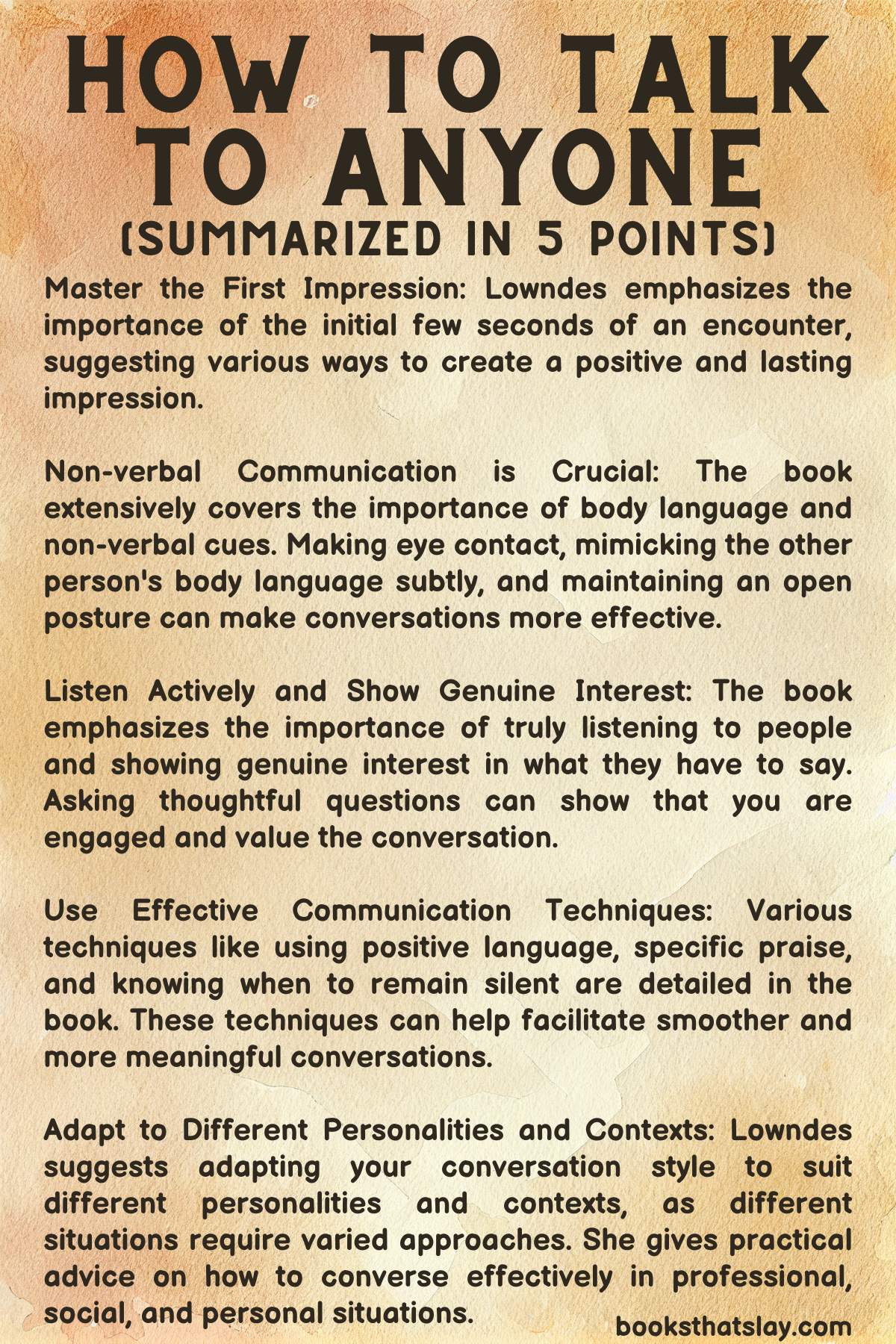How To Talk To Anyone | Book Summary
“How to Talk to Anyone: 92 Little Tricks for Big Success in Relationships” by Leil Lowndes is a comprehensive guide to improving one’s social skills and building strong, meaningful relationships with others. It includes 92 easy-to-use strategies or “tricks” which are categorized under different interpersonal situations.
How to Talk to Anyone Summary
The book is divided into 7 sections. Here’s each one of them.
- How to Intrigue Everyone Without Saying a Word: This section deals with how to make a powerful impression before even uttering a single word. It includes techniques for body language, maintaining eye contact, and even how to enter a room.
- How to Know What to Say After You Say “Hi”: This part focuses on starting and maintaining conversations. It offers advice on topics like the importance of small talk, how to come across as sincere, and how to be an engaging conversationalist.
- How to Talk Like a VIP: In this section, the book explores how to talk in a way that makes people perceive you as important or influential. This includes tips on building charisma, using the right tone and language, and mastering the art of listening.
- How to Be an Insider in Any Crowd: Here, the author shares ways to fit in with any group of people, how to connect with strangers, and even how to handle awkward situations or deal with difficult people.
- How to Sound Like You’re Peas in a Pod: This section presents ways to build rapport and empathy with others. It also provides insights on mirroring techniques and emphasizes the importance of validation in building rapport.
- How to Differentiate the Power of Praise from the Folly of Flattery: This section emphasizes the value of genuine praise over shallow flattery. It teaches readers how to offer sincere compliments that create a positive impression and strengthen relationships.
- How to Direct Dial Their Hearts: The final section delves into deeper, more emotional aspects of communication, helping readers connect on a heartfelt level. It covers topics such as dealing with negative emotions, handling disagreements diplomatically, and using storytelling to forge emotional connections.
Throughout the book, Lowndes uses anecdotal examples and practical exercises to illustrate her points, making the advice easy to understand and apply. Each trick is presented in a brief, stand-alone format so that you can easily pick and choose the ones that best fit your needs.
It’s important to note that although the book offers numerous tips and tricks for effective communication, these techniques are most effective when used sincerely, with a genuine interest in others, rather than as manipulative tools.

Also Read: The 5AM Club Summary
What can you learn from the book?
1. The Power of Positive Body Language
Studies show that more than half of communication is nonverbal, a fact that is emphasized throughout the book.
We learn the importance of making direct eye contact, having a firm handshake, and mirroring the body language of the person we are communicating with.
For instance, the author mentions the “Sticky Eyes” technique where, instead of just breaking off eye contact when finished speaking, one should break it off slowly and reluctantly, conveying that you’re deeply engaged in the conversation. This helps to build trust and rapport, even without uttering a word.
2. The Art of Small Talk
Small talk, often viewed as trivial, is underscored as an invaluable tool in building connections and relationships.
The book highlights the “Parroting” technique, which involves repeating the last few words your conversation partner said. This can demonstrate active listening and encourage the other person to continue speaking, fostering a sense of camaraderie.
For example, if a person mentions they’ve recently been on a trip to Italy, instead of immediately sharing your own experience, you could respond with “A trip to Italy? That sounds exciting.”
This allows the other person to elaborate on their experience, making them feel heard and valued.
3. Using Compliments to Build Rapport
The book emphasizes that flattery can be a powerful tool when used sincerely. It suggests a method called the “Killer Compliment” where instead of complimenting something obvious about the person, you compliment something new or unnoticed by others.
An example could be complimenting someone on their choice of jewelry or the unique way they’ve styled their outfit.
Instead of merely stating that they look nice, you’re pointing out something specific, making the compliment more personal and memorable.
4. The Power of Active Listening
Often, we tend to listen with the intention of responding, not understanding.
However, here Lowndes provides strategies to become a more effective listener. One of the techniques mentioned is the “Echoing” technique.
This involves echoing the speaker’s sentiments back to them, showing you not only heard what they said but also understood their feelings and thoughts.
For instance, if someone is sharing a tough experience at work, instead of immediately offering advice or sharing your own experience, you could say something like, “That sounds really challenging. It must have taken a lot out of you.”
This validates their feelings and lets them know that you’re genuinely interested in their story.
Also Read: